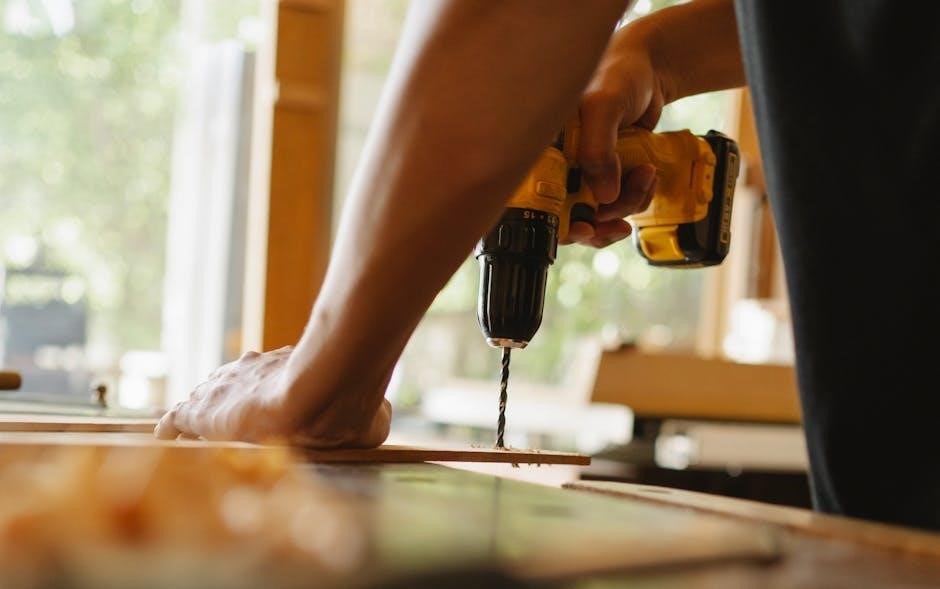HardiePlank installation is a process that enhances your home’s exterior with durable, long-lasting fiber-cement siding․ This guide provides a comprehensive overview of the steps, tools, and best practices to ensure a successful installation․
Overview of HardiePlank and Its Benefits
HardiePlank is a popular fiber-cement siding known for its exceptional durability and resistance to pests, moisture, and fire․ Its low-maintenance design makes it a top choice for homeowners seeking long-lasting exterior solutions․ Unlike traditional wood siding, HardiePlank does not rot or warp, ensuring a timeless appearance․ It comes in various styles and colors, offering versatility to match any architectural design․ Additionally, its fire-resistant properties provide an extra layer of safety․ HardiePlank is also eco-friendly, making it a sustainable option for modern homes․ Its resilience and aesthetic appeal make it a superior choice for enhancing both functionality and curb appeal․
Tools and Materials Needed
Essential tools include a circular saw, drill, utility knife, and siding nails․ Materials required are HardiePlank siding, weatherproof barrier, and flashing for a secure installation․
Essential Tools for HardiePlank Installation
Key tools for HardiePlank installation include a circular saw or miter saw for cutting, a drill for pre-drilling holes, and a utility knife for scoring siding․ Siding nails or screws are necessary for secure fastening․ A measuring tape and pencil are essential for accurate measurements and marking․ A pry bar helps remove old siding, while a caulking gun is used for sealing gaps․ Ladders or scaffolding are required for safe access to higher areas․ Safety gear like gloves and goggles should always be worn․ These tools ensure a professional and efficient installation process for your HardiePlank siding․
Required Materials for a Successful Installation
To ensure a successful HardiePlank installation, gather essential materials like HardiePlank siding boards, siding nails or screws, flashing for weatherproofing, and a weather-resistant barrier․ Additionally, trim and molding are needed for finishing touches, while caulk and sealants prevent gaps and leaks․ Fasteners, such asgalvanized or stainless steel nails, are crucial for durability․ A starter strip is required for the first row installation․ Make sure all materials comply with manufacturer guidelines to guarantee a secure and long-lasting finish․ Proper materials ensure the siding withstands environmental conditions and maintains its aesthetic appeal over time․

Preparation for Installation
Assess the wall surface, clean, and repair any damaged areas․ Ensure the area is level and install flashing or weather-resistant barriers for a smooth installation process․
Assessing the Wall Surface
Before installing HardiePlank, inspect the wall surface for damage, rot, or uneven areas․ Ensure the surface is clean, dry, and free of old adhesives or debris․ Check for any gaps or cracks and fill them with appropriate sealants․ Verify that the wall is level and plumb, as uneven surfaces can lead to installation issues․ Look for signs of mold or mildew and address them before proceeding․ Use a level and flashlight to identify any irregularities․ Proper assessment ensures a stable base for the siding, preventing future problems like warping or water damage․ This step is critical for a durable and visually appealing result․

Removing Old Siding and Preparing the Area
Begin by removing the old siding, taking care to inspect for damage or rot underneath․ Use pry bars or screwdrivers to gently detach siding without damaging the wall․ Dispose of old materials responsibly․ Once removed, clean the wall surface thoroughly, removing dirt, mold, or old adhesive․ Inspect for structural issues, such as rot or uneven areas, and repair them․ Ensure the wall is dry and secure before proceeding․ Cover the ground and surrounding areas with drop cloths to protect them from debris․ This preparation ensures a smooth and successful HardiePlank installation process, preventing future issues like warping or water infiltration․

Installing HardiePlank Siding
HardiePlank siding installation involves precise cutting, aligning, and securing boards․ Proper nailing techniques and spacing are crucial for durability and aesthetics, ensuring a professional finish․
Step-by-Step Guide to Cutting HardiePlank
Cutting HardiePlank requires precision to maintain its durability and appearance․ Begin by marking the plank with a pencil, ensuring measurements are accurate․ Use a circular saw with a diamond blade for straight cuts, or a jigsaw for curved edges․ Always wear safety goggles and a dust mask to protect against debris․ Cut slowly, applying steady pressure to avoid chipping․ For flourishes or detailed cuts, consider using a miter saw or hand tools․ After cutting, sand the edges to smooth any rough spots before installation․
Proper Nailing Techniques for HardiePlank
Proper nailing is critical for securing HardiePlank siding․ Use 1-1/2″ galvanized or stainless steel nails to prevent rust and ensure durability․ Fasteners should penetrate the studs or wood sheathing by at least 1″․ Space nails 16″ on-center for field nailing and 12″ on-center near edges and joints․ Avoid overdriving nails, as this can damage the siding․ Align nails with the nailing strip on the plank’s backside․ For butted joints, nail both sides within 1″ of the joint․ Use a pneumatic nailer for consistent results․ Double-check all nails to ensure they’re properly seated and spaced for a secure, long-lasting installation․
Ensuring Proper Spacing and Alignment
Proper spacing and alignment are vital for a professional-looking HardiePlank installation․ Begin by aligning the first plank with the bottom edge of the wall, ensuring it’s level․ Each subsequent plank should be staggered to avoid seam alignment, enhancing structural integrity and visual appeal․ Maintain a 1/8″ gap between planks for expansion and contraction․ Use a chalk line to mark stud locations, ensuring nails are spaced correctly․ Check each course with a level and plumb line to prevent misalignment․ Proper spacing prevents warping and ensures the siding adheres to manufacturer standards for durability and aesthetic consistency․
Finishing the Installation with Trim and Flashing
Finishing with trim and flashing ensures a polished and weather-tight installation․ Install trim around windows, doors, and corners using materials like PVC or fiber-cement to match your siding․ Flashing should be applied at joints, rooflines, and areas prone to water exposure to prevent leaks․ Use galvanized steel or PVC-coated flashing, securing it with compatible fasteners․ Seal gaps between trim and siding with weatherproof sealant․ Ensure all edges are tightly fitted and aligned for a seamless look․ Properly installed trim and flashing enhance durability, protect against moisture, and complete the aesthetic appeal of your HardiePlank siding․

Finishing Touches
Finishing touches involve painting, sealing, and final aesthetic enhancements to complete your HardiePlank installation, ensuring a professional and visually appealing result that withstands the elements․
Painting and Sealing HardiePlank
Painting and sealing HardiePlank siding is crucial for enhancing durability and aesthetics․ Use high-quality, 100% acrylic exterior paint specifically designed for fiber-cement surfaces․ Ensure the siding is clean, dry, and free of dust before painting․ Apply a primer if transitioning to a darker color or for uniformity․ Use a brush, roller, or spray gun for even coverage․ Allow the first coat to dry completely before applying a second coat․ Sealing is optional but recommended for added protection against moisture․ Follow manufacturer guidelines for paint and sealant compatibility to maintain warranty and ensure long-lasting results․ Proper painting and sealing will preserve the beauty and integrity of your HardiePlank siding for years to come․
Maintenance and Care
Regular maintenance ensures HardiePlank’s longevity․ Wash with mild detergent and water, inspect for damage, and caulk seams․ Trim plants to avoid moisture exposure․ Inspect fasteners annually and ensure proper ventilation to prevent rot․
Tips for Long-Term Durability of HardiePlank
For optimal longevity, maintain a cleaning schedule with mild detergents and avoid abrasive materials․ Regularly inspect and repair any cracks or gaps․ Ensure proper ventilation to prevent moisture buildup, which can lead to rot․ Trim nearby vegetation to reduce mold and mildew exposure․ Inspect fasteners annually and tighten as needed․ Avoid using harsh chemicals or high-pressure washes that might damage the siding․ caulking around windows and doors annually to maintain weather-tight seals․ By following these tips, you can ensure your HardiePlank siding remains durable and visually appealing for years to come․

Common Mistakes to Avoid
Improper nailing, insufficient spacing, and ignoring manufacturer guidelines are common errors․ Ensure correct tools and materials are used to prevent installation issues and ensure durability․
Pitfalls in HardiePlank Installation
One major pitfall is improper nailing, which can lead to siding damage and water infiltration․ Additionally, not leaving adequate spacing between planks can cause warping and unevenness․ Ignoring weather barriers or flashing installation increases the risk of moisture damage․ Cutting planks without proper tools or safety precautions can result in dust exposure and inaccurate fits․ Furthermore, not following manufacturer guidelines for nail placement and spacing may void warranties․ It’s crucial to address these issues early to ensure a durable and aesthetically pleasing exterior․
Manufacturer’s Recommendations
James Hardie recommends using approved fasteners, maintaining proper spacing, and applying compatible sealants․ Follow painting guidelines and warranty terms for optimal performance and durability of HardiePlank siding․
Warranty and Best Practices from James Hardie
James Hardie offers a comprehensive warranty program, ensuring long-term protection for your HardiePlank siding․ The warranty typically covers material defects for up to 30 years, depending on the product and location․ Proper installation following manufacturer guidelines is essential to maintain warranty validity․ Best practices include using approved fasteners, ensuring proper spacing, and sealing joints to prevent water intrusion․ Regular maintenance, such as cleaning and inspecting for damage, is recommended to uphold the product’s durability․ Adhering to these guidelines ensures optimal performance and extends the lifespan of your siding, backed by James Hardie’s trusted warranty․
